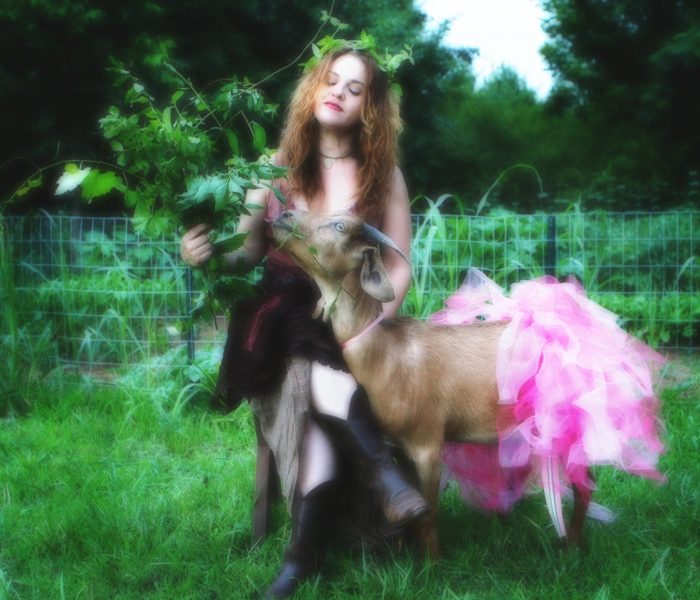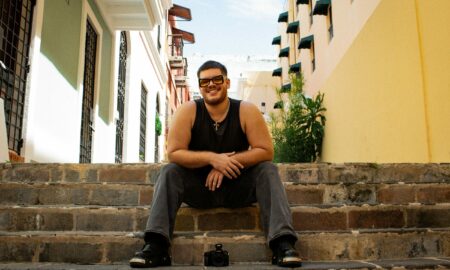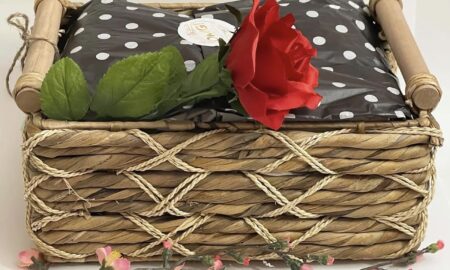

Today we’d like to introduce you to Angelina Bellebuono.
Angelina, can you briefly walk us through your story – how you started and how you got to where you are today.
In 1994, when my husband and I moved from our city home in Decatur to a new life just outside the rural Northeast Georgia town of Rutledge. I could never have imagined that I would someday be leading healing and heart-opening experiences on a farm with a herd of rescued goats.
A child of the suburban wasteland, I knew I needed land and nature and light, but I had no idea of what I’d do with it when I found it. Quite young and even more exuberant, my husband and I spent weekends for a year searching the 60-mile radius around Atlanta before we stumbled upon 5.3 acres and a vacant 1880s farmhouse. Immediately we were welcomed majestic oaks and wide porches and endless possibility. With the help of family and friends and much sweat equity, we restored the house simply and set about making it home.
The land, however, was a different story. Farmed in cotton since the 1800s, the land was spent, tired and red-clay furrowed. We longed for wildness, for forest, for a natural habitat for birds and native growth. The best we could do was reclaim the land, plant pasture grass, and hope for the earth to do her magic.
“Say Etta Aretha June and Loretta/four a chorus {listen to their insights: four tones, four voices, four opinions. They argue and often.}/ where Etta reigns queen/June, the only bearded lady/and Loretta fears the shadow of her/self, wide-sided and whitefleckedredcoated/she eschews human touch.” – excerpt from Goatballad: A Pasture Hymn
In 2005, we moved four newly weaned goats onto the pasture we’d summoned into being.
We named them Etta, Aretha, Loretta, and June. These four beautiful creatures forgave us for our ineptness, and as we grew into an awareness of what these animals carried with them in wisdom and grace, we realized that we, too, were changing. In that shift, we took on our first bottle-baby goat, who we named Gypsy, who captured our hearts completely. We had never seen a week-old baby goat. (Spoiler: we also had never cared for one.)
“…there is a single day of calm when gypsy comes to live in our pasture, a single balmy day at the first of April, a day where the earth seems gentle and nurturing, and the goats graze contentedly and do not notice at all that new baby frolics in their midst.” – excerpt from Goatballad: A Pasture Hymn
At the time, I was working as a photojournalist, and I was besotted with young Gypsy’s innocence and magic. I began dedicating personal time to documenting these insights into beauty, wonder and awe that both she and the chorus of four shared with me daily.
The five years between becoming owned by goats and gradually shifting into connection (and learning firsthand of both grief and loss) was a bit of a mystical journey. In 2010, the herd of (now) nine goats became locally famous with their own little art installation called “Goatballad: A Pasture Hymn,” held in The Caboose in downtown Rutledge, three miles from the farm.
Since our pasture runs along a busy road, many friends and neighbors had been watching the herd grow as we adopted orphaned or mother-rejected babies from nearby farms, and every family had stories about the antics and experiences they witnessed every day. At the opening of the show, I realized that there was much laughter, levity and joy.
All sorts of stories were shared, and whimsy celebrated. It was odd to me, at that first show, that goats could work such magic. The artwork sold. The show went on to travel throughout Georgia, Mississippi, and Alabama. More prints went home with those who connected with our story and our herd. I self-published “Goatballad: A Pasture Hymn,” a small book of images and multi-genre story from my experiences with the herd.
Mostly, I was intrigued by the effect the goats (even just in art form) had on the humans who interacted with the installation. In the hours spent driving to show, an idea developed. I wanted people to experience the awe that was inspiring me to create the art— the light and the way the breeze moves and the way magic spins on dragonfly wings. I began inviting people to the farm. Over and over, I found myself offering, “Please come to visit us at the farm. The goats would love to meet you.”
In early 2016, I was preparing new art for a show at Smith and Lens, a woman-owned gallery in Bay Saint-Louis, Mississippi. My husband said to me, “You should make trading cards of the goats. Like baseball cards.” I laughed, but when he sent me a website link to a playing card printing company, I downloaded the template and started work. Although I had no prior experience in digital collage, I created the deck: a set of 21 cards featuring each goat that we’d ever had and both livestock guardian dogs. A dear friend saw the deck and said, “You made oracle cards; give me a reading.”
When we moved Etta, Aretha, June, and Loretta into our pasture in 2005, I knew nothing about livestock, and as I designed the cards, I knew even less about divination. As a writer, artist and educator, I had done much research into the concepts of neuro-plasticity with emphasis on the emerging field of positive psychology, but I really had not delved into the softer, subtler work of accessing and acknowledging the energies that science sometimes eschews.
But I read her cards. And then I read the cards of others at show openings, local events, and at the farm. Every time I did a reading, I heard the same thing — the cards resonated with people. I was sharing archetypal stories of the detailed and nuanced personalities of our herd, yet I was being told that there was something universal in what I was sharing through the cards — and the goats.
I decided to listen to what the cards seemed to be saying. In the past two years, we have opened our home and farm for those wanting to experience the interactions with the animals, the farm and the natural world in ways less about science and more about the love, magic and healing we’ve discovered through the quieter, meditative reflection that has come with working with the goats and the pasture, and the woods and wilds that have risen from the once stark, red-furrowed fields.
Whether the experience involves a pasture oracle card reading, a walking meditation, gathering stone and leaf and feather, sketching out barn graffiti, singing to the goats or simply resting in the pasture, those who visit are welcomed with loving warmth, and invited into a world we have felt privileged to discover.
Great, so let’s dig a little deeper into the story – has it been an easy path overall and if not, what were the challenges you’ve had to overcome?
Because what we’ve discovered through working with the animals could only occur with time and experience, the struggles have shaped our vision and mission. While our first four goats were accommodating of our inexperience, our first bottle baby-goat, Gypsy, was not.
Despite our best efforts and constant, intensive care, Gypsy died at 18 months old. In her passing, we suffered a loss that was profoundly deep, and it led us to taking in our first four rescues within a month of her death. From bottle-feeding three of the four, and in spending hours with them in their pasture by the road, I began meditating and exploring the power of breath. I learned that much like putting a seashell to your ear to ‘hear’ the ocean, goats have a rhythm that provides a sense of calm — if you pay close attention.
“Instruction: visit the pasture mid-morning, sit quietly. Listen to leaf flutter, sunsong, goat breath. Maybelle may climb on you, tuck her knees beneath her, snuggle onto your lap. You feel her settle heavy, sink, love. Fancy will sit alongside you, her back against your leg. Listen to more goat breath. Then gurgle, chew. Feel the rhythm of their rumens working, the movements, the melody of their exhalations. Meditate. Ruminate. rejoice in the wonder of life.” – excerpt from Goatballad: A Pasture Hymn
Goats are ruminants— meaning they digest their food through a rumination process: they graze quickly for a period, and then settle into a relaxed, safe space and begin the contemplative process of burping up cud and chewing it, swallowing, and repeating this quiet, digestive work until the grass and browse is able to pass into their stomach for proper nutrient absorption. Young goats being bottle-fed and learning to graze will begin ruminating very young.
Sitting with a baby in the grass, feeling the rhythm of their rumen working can be its own special form of meditation. In Gypsy’s loss, there was growth. All the art and story and work that has followed has been in her honor. She was the medicine I needed to find myself. Without that struggle, I don’t think we would be doing what we’re doing today.
Please tell us about Oakhaven Farm {Goat} Sanctuary.
At Oakhaven Farm {Goat} Sanctuary, we have hand-raised goats who deeply connect with humans, the land and each other. We have habitat for all sorts of wild, magical creatures. An old farmhouse filled with and surrounded by ephemera, antiques, and art. We offer a safe, welcoming space for all people who want to process, grow, experience and learn.
Joy, wonder, awe, and harmony are words we use to describe what we feel here, and we invite people into that world, with us, through both movement and stillness, awareness and awakening. Although we have animals who enjoy engaging with humans, we are not a petting zoo.
We believe the goats are muses, storytellers—magical beings who offer subtle and gentle guidance into love, peacefulness, and acceptance. They are medicine makers, and we invite those who visit to savor what they experience and take away the medicine they need. We think of Oakhaven Farm {Goat} Sanctuary as a pasture apothecary, and we cherish the opportunity to share the magic that grows here.
Do you look back particularly fondly on any memories from childhood?
Dancing, twirling, believing in magic.
Spending hours beneath poplar and pines, running through freshly mowed grass, joyful for the irreverent dandelion that defied the manicuring of lawn, watching for the squirrels and rabbits and butterflies that made castles in and around us, despite our chain-link fences and split-level brick homes.
Words, nature, and animals filled the days and evenings, sunlight to dusk before nightfall and dinners with family.
Moving in and through the natural world, seeing the magic and feeling the quieter edges of life: these were the ways my younger self-created space for what I love the most about my adult life, now. I am grateful for her guidance.
Surely it is she who dances, sings and laughs through me today.
Pricing:
- Experiences begin at $25 per group
- Farm-magic art (including wax transfer prints/greeting cards/fine art photography prints/farm-art ‘medicine’) $5+
- Goatballad: A Pasture Hymn books $15
- Oakhaven Farm Pasture Oracle Cards $18 (discounted with experience/readings at the farm)
Contact Info:
- Address: 3820 Davis Academy Road Rutledge, GA 30663
- Website: www.oakhavenfarmgoatsanctuary.com
- Phone: 706.474.8127
- Email: oakhavenfarmgoatsanctuary@gmail.com
- Instagram: www.instagram.com/a_bellebuono/
- Facebook: www.facebook.com/oakhavenfarmgoatsanctuary/








Getting in touch: VoyageATL is built on recommendations from the community; it’s how we uncover hidden gems, so if you know someone who deserves recognition please let us know here.



















